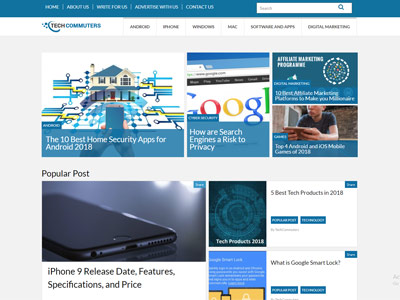What Makes the Best tech blog Stand Out Among Tech Enthusiasts and Specialists
What Makes the Best tech blog Stand Out Among Tech Enthusiasts and Specialists
Blog Article
Understanding the Rise of Side Computer in Today's Digital Globe
In the swiftly progressing landscape of modern technology, side computing becomes a crucial force, reshaping exactly how data is refined and made use of. This standard shift is driven by the spreading of IoT tools and an escalating need for immediate data handling. By transitioning data administration closer to the resource, side computer addresses essential latency issues while optimizing bandwidth use and enhancing safety procedures. As markets pivot towards smarter, extra efficient systems, understanding the nuances and implications of this technical improvement becomes important. What does this mean for future developments and the digital community overall?
What Is Edge Computing
Side computing, although a fairly current development in the world of technology, essentially changes how data is processed and taken care of by bringing computation and information storage space closer to the location where it is needed. Unlike typical cloud computing versions, which commonly rely upon central information facilities that can be geographically far-off, side computer decentralizes information handling. This distance minimizes latency, enhances real-time data handling, and improves the overall user experience by making sure much faster response times.
At its core, side computer includes a network of localized devices and facilities, such as routers, portals, and sensing units, efficient in refining information at or near the resource. This local handling capacity is specifically essential for applications requiring instant information analysis, such as independent vehicles, commercial automation, and wise cities. Furthermore, by unloading data processing tasks from central web servers, side computer minimizes data transfer demands and enhances information personal privacy and protection, as sensitive details can continue to be on-site instead than passing through substantial networks.

Key Chauffeurs of Fostering
Numerous aspects are propelling the fostering of side computer in today's electronic landscape. One of the key vehicle drivers is the exponential boost in connected tools, often described as the Web of Points (IoT) This rise develops huge amounts of data that require to be refined quickly and effectively. Edge computing addresses this need by enabling information processing closer to the information source, decreasing latency and boosting real-time decision-making abilities.
Another substantial chauffeur is the need for improved data transfer performance. Central cloud systems can end up being overwhelmed with the large quantity of data produced by IoT tools, bring about bottlenecks (Best tech blog). By refining data at the side, organizations can ease network congestion and improve total system efficiency
Additionally, safety and privacy worries are pushing organizations towards side computer. By processing delicate information in your area, firms can alleviate threats connected with data transmission and direct exposure to prospective cyber dangers.
The surge of applications requiring real-time handling, such as self-governing vehicles and boosted reality, also requires the fast feedback times that border calculating provides. Jointly, these vehicle drivers are making side computing an essential element of contemporary IT facilities, leading the way for its widespread fostering throughout numerous markets.
Advantages Over Cloud Computing
Exactly how does side computing distinguish itself from traditional cloud computing? Primarily, edge computing brings information handling closer to the resource of information generation, often on regional devices or nearby web servers, rather than counting on central data.
Moreover, side computing enhances bandwidth performance (Best tech blog). By refining information locally, just the required information is transferred to the cloud for more evaluation or storage space, minimizing the quantity of data that passes through the network. This not only reduces network blockage however also reduces data transmission prices
Side computer additionally provides better information privacy and safety. Sensitive data can be processed in your area without being check over here sent to the cloud, reducing the direct exposure to possible cyber threats. This is specifically useful for sectors taking care of secret information, such as medical care and economic solutions.
Furthermore, edge computing ensures greater resilience and integrity. Neighborhood handling enables for continued procedure even when connection to the cloud is endangered, preserving important features and solutions in spite of potential network disruptions. These advantages jointly demonstrate edge computing's transformative capacity in enhancing performance and security in digital communities.
Factors To Consider and obstacles
While side computer provides many benefits, it also presents one-of-a-kind obstacles and factors to consider that should be resolved to fully recognize its potential. One significant difficulty is data safety and security and privacy. Processing information closer to the resource increases the click danger of unapproved accessibility, demanding durable security and rigorous security methods to secure sensitive information. In addition, handling and checking a decentralized network of edge devices can be intricate, calling for sophisticated devices and techniques to ensure seamless operation and upkeep.
Another consideration is the scalability of side computer solutions. As the variety of linked devices expands, so does the need for refining power at the edge, which can lead to resource restraints. Organizations needs to thoroughly intend their framework to fit this development without endangering efficiency or effectiveness.
Interoperability is one more important factor. With numerous software and hardware parts involved, making sure compatibility and seamless integration can be difficult. Standardization efforts are necessary to assist in communication between inconsonant systems.
Future Fads in Edge Computer
Preparing for the future, side computing is poised to revolutionize different industries by enabling quicker information processing and minimizing latency. As the volume of information created by IoT gadgets proceeds to grow, side computer will end up being progressively crucial in managing this increase effectively. One considerable trend is the combination of synthetic knowledge at the edge, permitting real-time analytics and decision-making without depending on cloud-based sources. This change is anticipated to improve applications in autonomous automobiles, smart cities, and health care, where immediate data handling is vital.
One more emerging fad is the development of edge-native applications designed especially to leverage the special capabilities of side computing. These applications will certainly optimize efficiency and source application, resulting in boosted efficiency throughout numerous markets. Additionally, advancements in 5G modern technology will certainly even more strengthen side computing by offering the necessary framework for high-speed, low-latency interaction in between gadgets and side nodes.
Verdict
Edge computer's rise is driven by the spreading of IoT tools and the requirement for real-time data processing, which boosts performance by reducing latency and decentralizing data monitoring. This method original site minimizes data transfer inadequacies and safety issues, assisting in innovations in applications like smart cities and autonomous automobiles. In spite of challenges such as framework complexity and assimilation, the future of edge computing guarantees an extra receptive electronic ecosystem, with continued innovations shaping its advancement and broadening its applicability throughout sectors.
Edge computing, although a fairly current development in the realm of innovation, basically transforms how information is processed and managed by bringing calculation and data storage closer to the location where it is required. Unlike standard cloud computer versions, which often rely on centralized information facilities that can be geographically far-off, edge computer decentralizes information handling. In addition, by offloading information handling jobs from main servers, side computing lowers data transfer needs and enhances information privacy and security, as sensitive information can continue to be on-site instead than traversing comprehensive networks.

Report this page